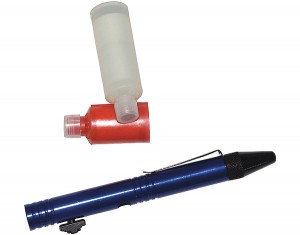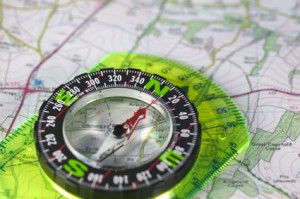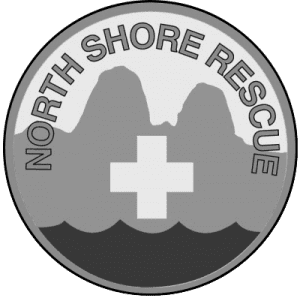
1. Light
Flashlight or a headlamp with extra batteries (and light bulb if not LED). Green cyalume stick or small turtle lights as emergency backup.

2. Signalling Device
Whistle (we recommend the Fox 40 whistle with a lanyard), Bear Bangers, Pencil Flare

3. Fire Starter
Matches (water proof or in plastic bag) or lighter. We also recommend a commercial firestarter and/or a candle. Commercial firestarters can be purchased at outdoor stores like Mountain Equipment Coop.

4. Warm clothes
Hat or toque, gloves or mittens, puffy jacket, gortex jacket, polypro underwear, good quality hiking socks and gortex over pants.

5. Pocketknife
Although a multi tool is preferred, a good pocket knife with a quality blade will suffice. It may also be worth carrying a small pruning saw for cutting branches when building a shelter or fire.

6. Shelter
Large orange plastic bag and thermal tarp.

7. Water and food
Gatorade crystals recommended and high energy food bars

8. First-aid kit
Should include pocket mask; Sam Splint, bulk dressings, protective gloves, bandage, scissors and blister dressings

9. Navigation
Good quality compass with built in declination adjustment and both topographical and interpretive maps. we also recommend a GPS unit but only as an adjunct to compass and map. Most team members carry a Garmin 60 series GPS unit that has terrific reception in the trees.

10. Communications – Cell phone
We recommend you bring a cell phone with a fully charged battery. It is advisable to keep the phone turned off, and stored in a ziplock bag. This way, if you get into trouble your phone will be dry and have a full charge. Many people manage to call 911 initially but their phone dies before their location can be relayed, not a desirable situation. If you have a smartphone, you should also know how to get GPS coordinates off of it to give to search and rescue if you become lost or injured (eg. MotionX or iphone compass app) . Depending on the terrain and difficulty of your excursion, it may also be worth considering satellite based communications devices like the Spot, Delorme InReach or a Personal Locator Beacon.
You can check out our educational guide on how to turn “Location services” on, here.
Important Tips regarding the 10 essentials:
The lack of light is the single most cause of overdure hiker calls for NSR. It is so easy to under estimate the amount of daylight left especially if you are deep in the forest. That is why carrying a good quality flashlight or headlamp with extra bulb and batteries per person, is number 1 on our list of the ten essential items. It is also prudent to carry green cyalume light sticks as an emergency backup ONLY. These lightweight items will illuminate the trail around and in front of you sufficiently for you to travel slowly in darkness fro several hours.
Note that training is required to develop efficient skills for use of a map, compass, and first aid kit, as well as to efficiently light fires. However having these items with you can make all the difference in a survival situation.
Why a large orange plastic bag? It’s actually one of the most valuable items on the list. Crawling into the bag helps keep you warm and dry. The orange colour is also highly visible and helps attract attention, particularly from the air.
Why a whistle? It is ideal for siganlling for help as your voice will become very hoarse in a short period of time especially if you are dehydrated. We reccommend the Fox 40 whistle because it works very well in wet conditions and has good range. When sending out a distress whistle blast do three short blasts in timed intervals of 1 to 5 minutes and in different directions from where you are standing as rescuers may be above below or to the sides of you, especially if you are lost in a canyon.If you here whistle blasts from rescuers it doesn’t mean that they can here you. Continue whistle blasts at even shorter intervals 1 minutes or less until they can make voice contact with you and the follow their instructions etc..
We also recommend you carry a heavy duty thermal blanket as this provides excellent shelter and reflects body heat.
Water especially, is an important essential item to take before and during your hike. We recommend you drink between 1-2 litres of water before and carry 1-2 litres. Hydration is directly proportional to your performance but also in maintaining essential fluid balance in your body. This is only a general guideline and is to be adjusted for extreme heat, cold, altitude, terrain etc. We also recommend you carry electrolyte, such as Gatorade in order to replenished salt and potassium that are depleted during excessive exercise. We recommend that you be always fully aware to take short rest and water breaks and hydrate yourself during your hike so as to avoid fluid depletion that leads to heat exhaustion and/or hypothermia.
We combined navigation and communications into number 9 and 10 essential items rather than creating the 11 essential items as they go hand in hand with each other. Knowing where you are and communicating your location in an emergency is a god send, both to yourself and the search and rescue team. As stated above you need proper training to orienteer with compass and map and a GPS should be seen as an adjunct to this. The GPS in itself is a valuable tool and depending on the type and price you want to pay you can get topographical maps downloaded onto the GPS. However, the GPS requires practice and it is not a substitute for orienteering skills especially if you are in terrain with natural obstacles such as canyons, cliff bands etc
The whole strategy to clothing is layering and breathability. This prevents overheating and sweating which can cause dehydration and begin the cycle of hypothermia in cold weather and heat exhaustion in relatively warmer weather. There are many clothing types on the market but you will want to wear underclothing next to the skin that wicks sweat away. It is also important to purchase fleece and gortex clothing that has venting zippers in the armpits and leg areas as this allows excess body heat to vent during times of heavy exercise in inclement weather. A fleece or woolen toque or hat is also a must as a great deal of body heat is lost through the head especially in children. Remember the saying ” if your feet get cold put your toque on”. Good quality woolen or gortex gloves or mittens are a must, especially in winter and inclement weather so as to prevent frostbite or cold injury. This will also allow you to perform tasks such as holding onto rocks or tree branches when traveling in terrain, wood gathering , lighting a fire etc. One additional little tip is to carry two good quality plastic shopping bags in case your boots get wet. You can put on your dry socks and wrap them in the bags then put your wet boots back on. This is great if you are stranded overnight and want yo keep you feet warm and be somewhat comfortbale.It can also prevent frostbite in cold weather in this type of situation.
We did not include footwear as an essential item to carry as it something that goes on at the start of your hike and stays on. Footwear selection from trail runners to approach shoes to light hikers to full mountaineering leather or plastic boots needs to be based on the type of activity you plan to carry out and the type of terrain you will travel in. Remember, if you buy new boots break them in long before your hike and have plenty of moleskin on hand to cover the potential hot spots that always seem to go with new boots. Also, good quality hiking socks are a must as these types of socks will wick sweat away from the feet thus reducing the risk of blisters or skin problems.
